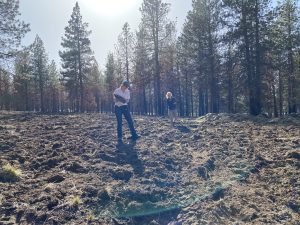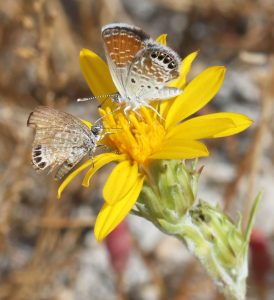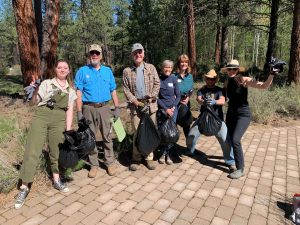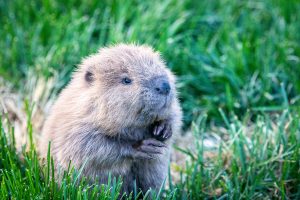Habitat Restoration and Rehabilitation
Invasive plants such as cheatgrass threaten ecosystems on a global scale. In Oregon, those changes can lead to increased wildfires and threats to wildlife populations. Non-native wildlife such as the American bullfrog, the red-eared slider and others are also impacting the region.
Controlling noxious weeds is only half the story of what the Museum does to keep the landscape and its biodiversity happy and healthy. The Museum’s staff and volunteers are committed to restoring the landscape and revitalizing habitats both on and off the Museum grounds. Daily interpretative talks and the Museum’s Weed-Pulling Team highlight the need for visitors to do their part, too.

Conservation in action
 Solarization is an eco-friendly weed management technique that is used in agriculture. From 2021-2023, the Museum placed large plastic sheets on 2 acres of Museum property to remove cheatgrass and other invasive plants growing at the site. They remained on the ground through the spring and summer months. In September 2022, native species were replanted and the Museum established an irrigation system.
Solarization is an eco-friendly weed management technique that is used in agriculture. From 2021-2023, the Museum placed large plastic sheets on 2 acres of Museum property to remove cheatgrass and other invasive plants growing at the site. They remained on the ground through the spring and summer months. In September 2022, native species were replanted and the Museum established an irrigation system.
The result? Native species are back! Sagebrush, coyote tobacco, silverleaf phacelia, fireweed, penstemon and common yarrow are just a few of the plants that have returned to the area. In addition, the Weed-Pulling Team weeds at the site weekly to keep those noxious weeds at bay.
 The Museum’s 135-acre forested property naturally supports dozens of native plants, which in turn provide habitat for native pollinators including bees, moths and birds. An ongoing effort, the Museum continues to build pollinator habitats, or islands, which are not only beneficial for native pollinators but also for visitor interpretation and education.
The Museum’s 135-acre forested property naturally supports dozens of native plants, which in turn provide habitat for native pollinators including bees, moths and birds. An ongoing effort, the Museum continues to build pollinator habitats, or islands, which are not only beneficial for native pollinators but also for visitor interpretation and education.
The result? In 2020, the Museum chose 3 acres to develop condensed pollinator islands. Invasive plants were removed and irrigation installed. Plants are continuously added to the acreage, welcoming bees and birds. In the future, the Museum plans to expand interpretation around its pollinator habitats including promoting SAFE monarch butterfly education, planting milkweed and monitoring for butterfly populations.
 Museum staff and volunteers are constantly at work pulling noxious weeds and invasive plants from the Museum’s property. The Weed-Pulling Team is often out on property during the spring and summer months, pulling weeds and tossing them into a wheelbarrow or trash bag.
Museum staff and volunteers are constantly at work pulling noxious weeds and invasive plants from the Museum’s property. The Weed-Pulling Team is often out on property during the spring and summer months, pulling weeds and tossing them into a wheelbarrow or trash bag.
The result? The Museum has an ongoing plan to map, track and remove invasive species from the property. By tracking them, the Museum can reduce their chance of returning every year. Education and information helps spur change in the community while also fostering love for and appreciation of the Deschutes National Forest.
 Beavers once numbered in the millions in Oregon, but due to centuries of trapping, their numbers remain low. In 2021, the Museum partnered with BeaverWorks to cut willows from the Museum’s riparian habitat, which were then transplanted in Eastern Oregon to help restore lost beaver habitats.
Beavers once numbered in the millions in Oregon, but due to centuries of trapping, their numbers remain low. In 2021, the Museum partnered with BeaverWorks to cut willows from the Museum’s riparian habitat, which were then transplanted in Eastern Oregon to help restore lost beaver habitats.
The result? The Museum’s willow cuttings were available for a variety of restoration projects, including stream restoration initiatives led by the United States Forest Service and the Theodore Roosevelt Conservation Partnership.
